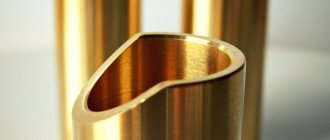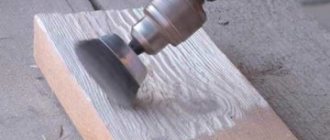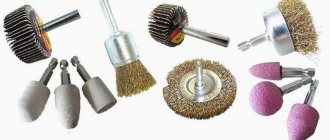What is polishing
Polished surfaces look much more beautiful than raw materials. The wood is given the desired shade, emphasizing the decorative nature of the natural pattern. Additionally, the wood is protected from moisture, mechanical damage and absorption of foreign odors. The products are not afraid of aggressive household chemicals and fungal processes.
For polishing, they use compounds that professionals call varnish. Using special technology, thin layers are removed from the processed material. The characteristics of the products resemble varnishes, but they allow you to obtain a more transparent, lighter coating.
Application of wax mastic
Wax-based mastic is the main product for caring for parquet floors. Parquet - both expensive and ordinary wood species are treated with beeswax-based mastics. The mastic is applied manually using a rag in a circular motion. The parquet is polished manually or with a grinding machine and a polishing wheel.
If the parquet is new, then the floors are treated with mastic 2-3 times. Between processing processes, technological breaks are taken to allow the next polishing layer to dry completely. The final coating is rubbed until the floor is shiny and glossy.
What is it processed with?
The quality of processing and ease of polishing depend on the polish. When choosing a composition, pay attention to the functions that the substance should perform and the characteristics of the surface (varnished, clean). For convenience, all pastes were divided into two volume groups.
Ready-made products
Professional wood polishing chemicals are sold in hardware stores. The substances include resins, waxes and solvents. Depending on the consistency, there are three types of products:
- Dense. Designed for machine polishing. Due to their thickness, the chemicals are difficult to work with without additional equipment (manually).
- Wood polishing pastes. Substances with a creamy consistency are easy to spread over the coating and process without professional equipment.
- Liquid. Suspensions are designed to restore the gloss of wood.
Abrasive chemicals are used for initial treatment. Coarse particles in the composition ensure surface leveling. After removing the top wood fibers, medium polishing agents are used. The final stage is the creation of a mirror gloss on the raw material.
If you need polishing of acrylic varnish on wood, we recommend updating your selection to products from the 3m and Menzerna brands. Thin and medium-thick pastes of both brands are used for three-stage processing of varnished wood.
Product from TM 3m Source kraski-laki-gruntovka.ru
Some manufacturers offer both individual shine products and complex solutions. For example, the polishing system from Mirka contains not only suspension pastes, but also equipment with accessories. The customer can buy the entire polishing set in one place.
Not all substances should be used in aggressive conditions. The composition based on cellulose and esters is not afraid of fats and water. The wood will not lose its gloss even after exposure to boiling water. The suspension is applied both manually and using a spray bottle.
Glazing solution Source gribnick.org.ua
Products used for polishing wood
For polishing wood, commercial establishments offer a large list of various finishing substances:
- Shellac varnish – used for finishing furniture.
- Alkyd varnish – used to cover parquet.
- Acrylic varnish – used for processing wood products.
- Polyurethane varnish - used to protect wooden products from precipitation.
- Nitrovarnish - used for processing wooden products.
You can make a polish for polishing wood at home using certain substances:
- shellac resin - 60 g;
- ethyl alcohol 90* - 500 ml.
The manufacturing process is quite simple. Resin is poured into a glass container and filled with alcohol, mixed well, closed with a tight lid and infused until the resin is completely dissolved. Next, the composition is filtered and used for its intended purpose for polishing wooden products.
Algorithm of actions
Polishing wood is a complex process consisting of several stages. The final result depends on the sequence and correctness of the performer’s actions. Let's consider the algorithm for unvarnished surfaces.
Grinding
The wood must be cleaned of defects, burrs and cracks. Before polishing, the wood must be sanded with abrasive paper No. 46-60. Then it is treated with finer sandpaper (80-100) and finished with very fine sandpaper (140-170). After the procedure, the surface becomes very smooth and even.
First stage Source 24shopping.com.ua
Padding
The wood is coated with shellac varnish. The suspension is applied using a linen swab. If you use a different type of material, then defects (lint, threads) remain on the wood. A small amount of solution is carefully distributed over the surface, trying to cover different directions. With this technique, it will be possible to saturate microcracks as much as possible.
High-quality polish dries quickly. There are no defects or blisters on the coating. Professionals recommend treating a test surface before polishing the wood. Remove excess with a piece of rag.
After priming, the product is left to dry. On average, the process takes up to 3 days. After polymerization, the wood is sanded. We recommend using fine-grit sandpaper. Any dust that forms is carefully removed with a cloth.
Second stage Source dreamhomesbyrob.com
Polishing
A few drops of vegetable oil are applied to a flax swab and shellac polish is added. Fat improves gliding on the wood surface. When polishing, more alcohol is added to the solution than resin.
During processing, the cloth is carefully passed over the wood. According to technology, they move in slow circular motions. Shellac is applied in three layers. Between tiers a period of complete drying is maintained, sanding with fine sandpaper and cleaning from dust. A light shine will begin to appear after 3 applications.
Compound
Vegetable oils are used to make the material:
skeleton
linen
soy
sunflower
As for wax, one of three types of this material is used to produce the product:
Carnauba
Extracted from the leaves of the Brazilian wax palm. Refractory material of increased hardness. It is safe to use because it does not emit toxic substances and does not cause allergic reactions. For this reason, oil with the addition of this type of wax can be used to treat wooden furniture even in children's rooms.
Candelilla
Extracted from the Canelilla bush. Refractory material, safe to use. Does not provoke the appearance of negative reactions in the body, does not emit toxic fumes. This, just like with the previous option, allows you to use oil and wax to treat furniture in children's rooms.
Bee
This wax, unlike the two previous materials, is not refractory. Its melting point is only +350C. However, its manufacturers also use it to make furniture polishes. This is not surprising, because the product helps level the surface, gives it an attractive shine, and creates reliable protection from external negative influences.
In addition to the main components, the material usually contains the following components:
- paraffin;
- solvents;
- driers - elements that reduce the drying time of the product;
- dyes - these elements are absent in colorless compositions;
- additives – protect the base from the negative effects of ultraviolet radiation, which prevents the surface from fading.
How to polish varnish
When working with a varnished surface, first smooth out the unevenness. The polish is applied to the tampon. Using continuous zigzag movements, distribute the composition over the tree. The material with the solution cannot be held for a long time at any point. If the product comes into contact with the transparent layer for a long time, it will corrode the area. A cloudy spot will form in the problem area, which is difficult to remove.
Restoration of the table Source market-crimea.com
Before polishing the varnish, the wood is sanded. We recommend using a sander with discs of different grain sizes. At the initial stage, take the coarsest sandpaper (600-800), gradually moving to fine sandpaper (1000-1500). During processing, dust is generated, which is removed with a construction vacuum cleaner or a napkin. When replacing the nozzle, the debris is completely removed.
When using grinding equipment, choose moderate or low speed. At maximum mode, the varnish heats up, melts and sticks. When working with nitro varnish and polyurethane composition, the equipment is set to the slowest speed or sanded by hand.
How to polish correctly Source luxury-house.org
After treatment, the wood is left to dry for 7 days. After polymerization, the procedure with the polish is repeated. The swab is moved over the surface in movements reminiscent of figure eights. To polish acrylic varnish, you can use a sander at medium speed.
The second drying lasts 10 days. Then they start polishing. The wood is rubbed with a cloth soaked in alcohol. The procedure facilitates the removal of polish residues, especially oil components.
Matte varnishes should not be polished. After drying, a transparent velvety surface appears on the wood. Glossing will spoil the decorative effect and give the material a slight shine. The procedure is relevant when the coating is damaged, helping to mask scratches or hide drips.
The best cleaning polishes for furniture
Furniture must not be cleaned with solvents, alkalis, acids or dishwashing detergents. Special polish cleaners contain soft surfactants that remove grease stains and other contaminants without harming the material. However, it is still recommended to wear gloves when working with this type of product.
Nihon Detergent
4.9
★★★★★
editorial assessment
97%
buyers recommend this product
Japanese spray foam for cleaning and polishing various surfaces equally well cares for furniture made of different materials and electrical appliances, helps clean and polish the floor.
The composition removes greasy and sticky stains, stubborn dirt, and food debris. Polish makes the surface smoother and shiny. After using the product, a subtle citrus aroma remains on the furniture.
The composition is sold in 400 ml plastic bottles. A finely dispersed sprayer is convenient for applying polish to large surfaces; the splashes do not scatter in different directions.
Pros:
- suitable for different surfaces;
- cleanses contaminants of any origin;
- adds shine;
- light citrus aroma;
- Convenient packaging with a spray bottle.
Minuses:
- high consumption.
For frequent washing of complex stains, a bottle of Nihon Detergent lasts only a few weeks of use.
Cleaner-polish for wood Emsal
4.9
★★★★★
editorial assessment
94%
buyers recommend this product
The German product Emsal polishes and carefully cleans wooden furniture. The almond oil in the composition takes care of the surface, but does not leave greasy stains after cleaning. Thick creamy texture fills small scratches and makes large ones less noticeable.
To clean old stains, leave the polish on for 5-10 minutes and only then wipe the surface. After polishing, dust settles much more slowly - the antistatic effect lasts for a week. The pleasant honey-almond aroma lingers on the furniture for several hours.
Pros:
- aroma of almond and honey;
- makes scratches less noticeable;
- cleans old stains;
- has an antistatic effect.
Minuses:
- the surface becomes slippery.
It is not recommended to rub Emsal polish on staircase steps or other wooden floor coverings. After processing, a thin film will remain, which is easy to slip on.
Premium House
4.8
★★★★★
editorial assessment
93%
buyers recommend this product
Multifunctional product Premium House polishes wooden furniture and cleans it of all types of dirt. The composition gently cares for the surface, easily copes with everyday dirt, fingerprints and restores shine. After processing, a protective layer remains that prevents natural wood from drying out and reduces the amount of dust.
The composition has a rich smell that can be felt on the furniture for some time. The polish is sold in 500 ml plastic bottles with a convenient dispenser spout.
Pros:
- does not leave marks on furniture;
- creates an antistatic effect;
- convenient to dose;
- reasonable price (200 rubles for 500 ml).
Minuses:
- damages metal surfaces;
- not everyone likes the smell.
For best results, the Premium House composition should be left on the surface for 5-10 minutes, and then rub and rinse particularly dirty areas of the furniture.
Sano Leather care
4.8
★★★★★
editorial assessment
91%
buyers recommend this product
This comprehensive skin care product cleanses and adds shine to any product: furniture, bags, accessories and shoes. The polish restores elasticity to the surface and softens old, rough skin. The effect is visible after the first use.
After treatment, the surface is protected from moisture and mechanical damage and remains clean longer. Stains from salts and reagents do not appear on shoes for several days.
To apply the product to a small surface, a few drops are enough. The polish distributes well and penetrates deep into the skin structure. One bottle will last for several months even with frequent use.
Pros:
- low consumption;
- softens the skin;
- gives the surface shine;
- quick result.
Minuses:
- requires precise dosage;
- high price - 600 rubles per 500 ml.
You only need a small amount of Sano to clean and polish leather items. If you overdo it, you may end up with whitish streaks or a sticky layer.
In conclusion
Every day, throughout our lives, we subject things to tests - touches, impacts, placing them in the scorching sun or a damp terrace. Often, thanks to a decorative coating, it is possible to preserve/restore furniture, decorative elements or objects of art for a long time.
If you want to get super gloss on your furniture, the video in this article will reveal all the secrets of this process.
Wood, as one of the most popular materials for the manufacture of furniture, requires a special finishing that will emphasize its natural beauty and extend its service life .
This process is called polishing. Of course, it is difficult to perform , takes a lot of time, and all actions must be carried out very carefully. Despite the difficulties, polishing wood allows you to create a glossy surface , the main thing is to know the subtleties of the process.
How to properly apply wax to wood so that the wood does not rot and lose its attractiveness?
Wood is used in interior design, as a facing material for floors, stairs, walls, and during construction work. In order for it to remain beautiful, textured and retain its natural shade, it is important to process the lumber in a timely manner using special products, such as wax.
Waxing has been known to mankind as one of the ways to protect wood for more than 1000 years. Modern market wax impregnations and similar products contain additional components that significantly improve the primary properties of wax as a protective agent.
Wax for impregnating wood is suitable for various types, it interacts especially well with coniferous species, ideally preserving their amazing aroma and special texture.
Top 6 reasons to wax before or after tiling:
- A thin protective film is formed on the surface, which will protect the material from the influence of moisture. Due to this, coated lining and other lumber can be used in kitchens and hallways.
- The product penetrates the fibers as deeply as possible, strengthening them and making them stronger. But at the same time, the wax does not clog the pores and leaves the wood the opportunity to “breathe”. High-quality air exchange allows you to avoid rotting processes and various deformations.
- Applying wax to wood makes it possible to significantly improve the visual characteristics: emphasize the natural texture, enhance the natural shade, give a charming matte shine, for which builders and designers love this finishing material. If you use wax with coloring components, you can additionally adjust the color scheme of the source material.
- Effectively protects the coating from mechanical stress and excessively active loads. Thanks to the dense layer of wax, it is almost impossible to make scratches.
- A natural product containing exclusively beeswax. Can be used on surfaces that come into direct contact with food, such as countertops.
- Amazingly high-quality masks a variety of scratches and cracks on wood.
Hard wax for wooden surfaces
Selection of oil-wax
The key criterion is the composition of the product, what components are included in it. The final result and tone of the wood directly depend on this.
The product consists of:
- oil (linseed, olive or jojoba),
- beeswax,
- tints for color saturation,
- a solvent that makes the product not so thick (the lower its mass fraction, the faster the hardening occurs).
If you buy a ready-made product, make sure that the composition does not contain aggressive solvents or benzene. It is also necessary to take into account the type of wood, since both the absorption rate and the consumption of the product directly depend on this. Compositions for hardwood, softwood and exotic woods are available.
Oil-wax often contains additives that make the surface glossy and shiny. It looks impressive, and this product is suitable for interior work. But be careful, as the coating becomes slippery when treated with the composition.
Frequency of parquet flooring renewal
The frequency of organizing polishing work depends on several points, among which the following can be highlighted:
- degree of load on the coating. The level of wear can be determined based on the mechanical load placed on the floor. If, for example, you often have to receive guests or rearrange furniture, you will have to perform this procedure much more often.
- type of coverage. Oil-wax mixtures penetrate much deeper into the wood pores, providing protective properties to the board, but not its surface. Here, various contaminants accumulate, thereby creating the need for polishing work. Varnish, on the contrary, helps create a film that allows the floor surface to be protected for a longer time. On the other hand, varnish is inherently shiny, but it tends to peel off under constant loads.
- room dimensions. The dimensions of the home have a direct impact on both the choice of polishing agent and the more optimal option for its use.
- finance. The cost of polishing a parquet board on your own directly depends on the cost of materials, and when ordering a service, it is calculated directly by an organization specializing in this field.
In most cases, users make absolutely no calculations based directly on the general and external condition of the parquet flooring.











